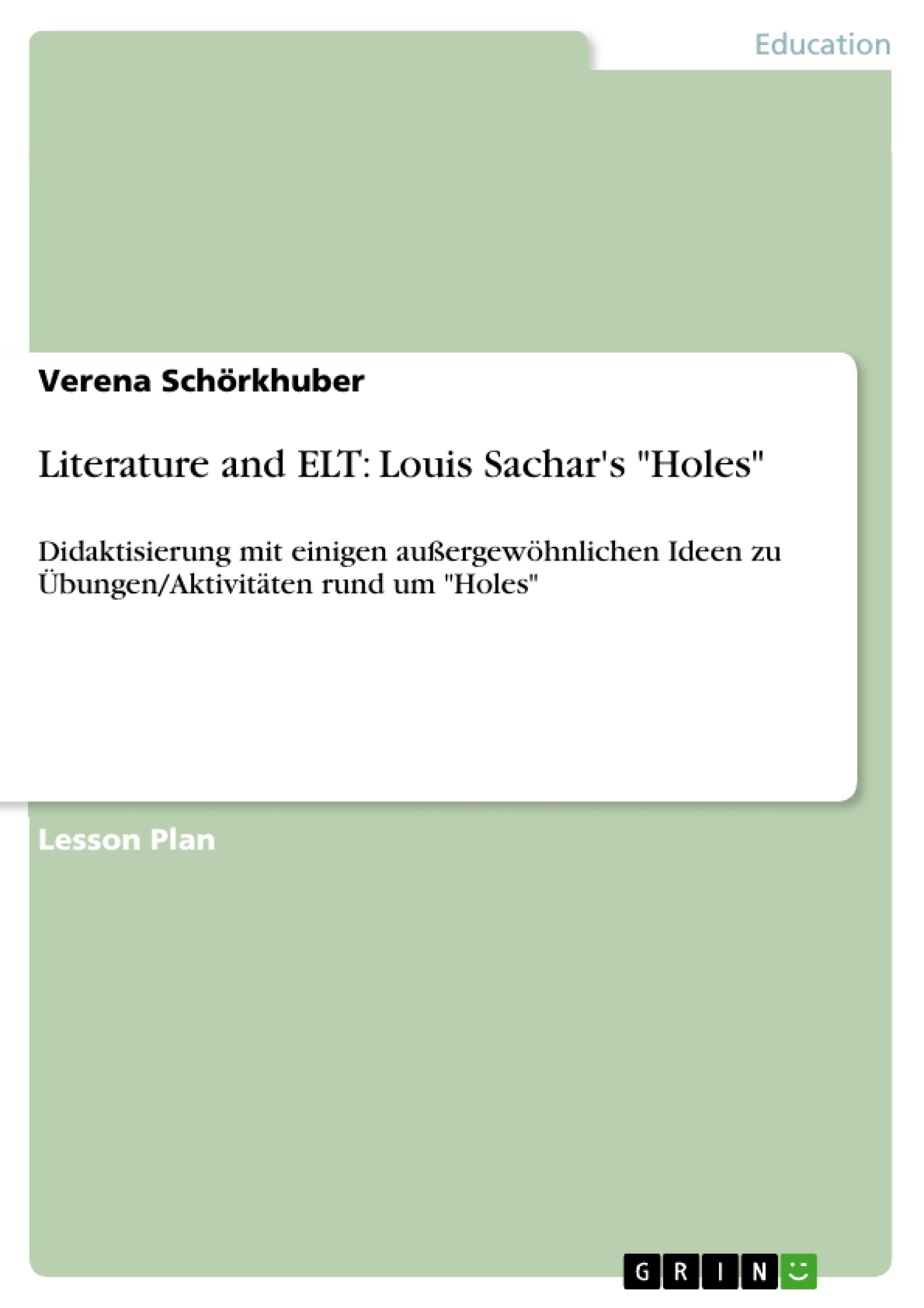Bei dieser Arbeit für den Fachdidaktik-Kurs "Literature and ELT" handelt es sich um eine Didaktiksierung des Abenteuerromans "Holes" von Louis Sachar (ab 4./5. Lernjahr) mit einigen außergewöhnlichen Ideen zu Übungen/Aktivitäten rund um "Holes" (Dauer ca. 4 St.), welche auch auf andere literarische Werke angewandt werden können (creating wanted posters, telephone conversations with the author, ...).
Inhalt: Introduction: Why teach literature (or Literature?) in ELT; Choice of text; Work plan for four lessons; Conclusion; Bibliography; Appendix/Work sheets: 'dig it', character sketch, 'mad lib', discuss-decide-survive, filling in the holes: questions, create your own 'wanted poster', reading log.
Auszug: Choice of text
We shouldn’t teach great books; we should teach a love of reading. (B. F. Skinner)
I have chosen the novel Holes by Louis Sachar with the quotation above in mind: even though it might not be classified as one of the ‘great books’, i.e. of ‘(high) Literature’, it is definitely one of those books that can serve to ‘teach a love of reading’.
Holes is the exciting story of Stanley Yelnats (mind the palindrome!), an overweight boy who is unjustly sent to Camp Green Lake, a boys’ juvenile detention centre. Stanley knows that this is due to a curse on his ‘no-good-dirty-rotten-pig-stealing-great-great-grandfather’, who did not fulfil a promise he had made to Madame Zeroni. At the camp, Stanley and six other boys are forced to dig holes every day in order to pay their debt to society. However, Stanley soon finds out that there is more than ‘character building’ going on [...].
The novel and its main themes (friendship, racism, justice, fate, etc.) can be exploited in many appealing ways for classroom reading. [...] In the open learning sequence I have prepared, two basic approaches to reading a book in class are incorporated. First, there is the ‘classical’ approach with its well-established, successful activities, whereby the focus of assessment is (as is usual on an upper-secondary level) on both language and content. On the other hand, the activities on the second work sheet focus on the themes dealt with in the book. Since friendship, bullying, racism, etc. are issues in (nearly) every teenager’s life, it can be motivating for the students to deal with these topics from a personal point of view, in a creative way. The activities on both work sheets are designed in a way that allows the students to plan which tasks to do when themselves.
Inhaltsverzeichnis (Table of Contents)
- Introduction: Why teach literature (or Literature?) in ELT
- Choice of text
- Work plan for four lessons
- Conclusion
Zielsetzung und Themenschwerpunkte (Objectives and Key Themes)
This text examines the role of literature and Literature in English language teaching (ELT). It aims to address the question of why and how literature should be incorporated into ELT classrooms, considering its potential benefits for language acquisition, cultural understanding, and student engagement.
- The value of literature and Literature in promoting language learning and cultural sensitivity.
- The importance of selecting appropriate texts for different language levels and interests.
- The use of literature as a springboard for communicative activities and authentic language use.
- The role of literature in fostering critical thinking, imagination, and personal growth.
- The different models for teaching literature in ELT: the cultural model, the language model, and the personal-growth model.
Zusammenfassung der Kapitel (Chapter Summaries)
Introduction: Why teach literature (or Literature?) in ELT
This chapter explores the rationale for incorporating literature into ELT, drawing upon Coleridge's analogy of "mogul diamonds" to emphasize the role of teachers as facilitators of enjoyable and enriching reading experiences. The chapter discusses the potential benefits of literature in promoting language acquisition, cultural understanding, and student engagement. It examines the complexities surrounding the integration of literature into ELT, considering various perspectives and challenges. The chapter highlights the importance of carefully selecting texts that are appropriate for students' language proficiency and interests.Choice of text
This chapter is not included in this preview to avoid revealing the specific text chosen for the lesson plan.Work plan for four lessons
This chapter is not included in this preview to avoid revealing the details of the lesson plan.Schlüsselwörter (Keywords)
The main keywords and focus topics of this text include: literature, Literature, English language teaching (ELT), language acquisition, cultural sensitivity, communicative competence, student engagement, critical thinking, imagination, personal growth, teaching models, text selection, language proficiency, and authentic language use.
- Quote paper
- MMag. Verena Schörkhuber (Author), 2012, Literature and ELT: Louis Sachar's "Holes", Munich, GRIN Verlag, https://www.grin.com/document/200174




